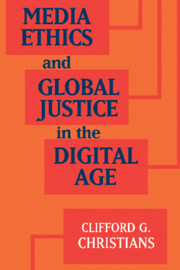Book contents
- Media Ethics and Global Justice in the Digital Age
- Communication, Society and Politics
- Media Ethics and Global Justice in the Digital Age
- Copyright page
- Dedication
- Contents
- Foreword
- Acknowledgments
- Introduction
- 1 The Technological Problem
- 2 The Ethics of Being
- 3 The Ethics of Truth
- 4 The Ethics of Human Dignity
- 5 The Ethics of Nonviolence
- 6 Cosmopolitan Justice and Its Agency
- Afterword
- References
- Index
- Other Books in the Series (continued from page ii)
- References
References
Published online by Cambridge University Press: 18 March 2019
- Media Ethics and Global Justice in the Digital Age
- Communication, Society and Politics
- Media Ethics and Global Justice in the Digital Age
- Copyright page
- Dedication
- Contents
- Foreword
- Acknowledgments
- Introduction
- 1 The Technological Problem
- 2 The Ethics of Being
- 3 The Ethics of Truth
- 4 The Ethics of Human Dignity
- 5 The Ethics of Nonviolence
- 6 Cosmopolitan Justice and Its Agency
- Afterword
- References
- Index
- Other Books in the Series (continued from page ii)
- References
- Type
- Chapter
- Information
- Media Ethics and Global Justice in the Digital Age , pp. 338 - 390Publisher: Cambridge University PressPrint publication year: 2019



